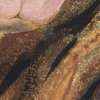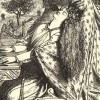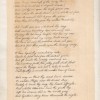
Joseph Viscomi, “William Blake’s 1818 Letter to Dawson Turner and Later Career as Graphic Artist”
Blake printed approximately 157 copies of sixteen illuminated books between 1789 and June 1818. All but fourteen were printed by the end of 1795, by which time Blake had copies of all saleable books in stock and began taking on new “designing and painting” projects. In the twenty-three years between 1795 and 1818, Blake printed illuminated books only four times, for fourteen copies of four titles. In 1818, Blake received an enquiry from Dawson Turner for a “selection” of illuminated designs printed in colors like those Blake had produced for Ozias Humphry in 1796 and which are now known as the Large Book of Designs and Small Book of Designs. Blake refused and redirected Turner to illuminated books and large monoprints, none of which he purchased. Nevertheless, Blake’s letter to Turner marks the moment when Blake was willing to return to a body of work that, with very few exceptions, he had not touched in more than two decades and which he had explicitly declined to reprint in 1808. That decision in 1818, along with a commission from another collector shortly after he wrote Turner, made possible his resurgence in his last decade, as poet, publisher, illustrator, painter, and, equally significant, as original graphic artist. This essay examines Blake’s letter in detail to reveal why he refused Turner’s request, had stopped printing most of his illuminated books, and stopped color printing and monoprinting altogether. It reads the letter closely in light of Blake’s labor history to reveal the idea he had of himself as an artist, the attitude he had toward the hierarchy in the arts, and the works he believed made his “great reputation as an Artist.”

Lorraine Janzen Kooistra, “The Moxon Tennyson as Textual Event: 1857, Wood Engraving, and Visual Culture”
By convention the launch of the so-called “golden age” of wood-engraved illustration in Britain, also known as “the sixties,” is Edward Moxon’s publication, in May 1857, of Alfred Tennyson’s Poems, with 54 wood-engraved illustrations designed by 8 artists, including the Pre-Raphaelites John Everett Millais, William Holman Hunt, and Dante Gabriel Rossetti. Although the Moxon Tennyson was neither a commercial nor critical success on first publication, before the decade was out its Pre-Raphaelite designs were considered a touchstone for artistic illustration, a reputation that continues today. Without disputing the significance of this aesthetic achievement, I want to shift critical focus to the Moxon Tennyson’s status as mass-produced work of art in the age of mechanical reproduction. My interest here is in how its visual communication was expressed through its reproductive technology at the historical moment of its production and reception. This essay re-positions the Moxon Tennyson as a textual event by reading it in the context of documentary, satiric, and artistic wood-engraved images selected from the crucial six-month period after its publication. By situating the Pre-Raphaelite illustrations for Tennyson’s Poems in relation to representations in the public press of such disparate events as the Art Treasures of the United Kingdom Exhibition in Manchester, the reportage on Indian uprisings at Meerut and Cawnpore, the Matrimonial Causes Act, and the Christy Minstrels show in London, I aim to show the complex ways in which the Moxon Tennyson was a worldly event, caught up in, and contributing to, ways of seeing and knowing in 1857.

Joseph Viscomi, “Blake’s Invention of Illuminated Printing, 1788”
William Blake invented a printing technique known as relief etching and used it to print most of his poetry. He called the technique illuminated printing and the poetry illuminated books. Nearly all of his critics believe that the idea for illuminated books preceded the invention of relief etching, that either the idea of text integrated with images on the same page or Songs of Innocence actually mocked up on paper was the mother of invention. This essay, however, approaching the question of the technique’s origin from the context of other new print technologies of the day, argues that illuminated poetry was the child and not the mother of invention. There were no “illustrated songs” on hand or even in mind needing a technique by which they could be printed in facsimile. Blake’s idea of publishing himself occurs only after the invention of relief etching, once he sees that he could use his new mode for writing as well as images and both in the same space.
